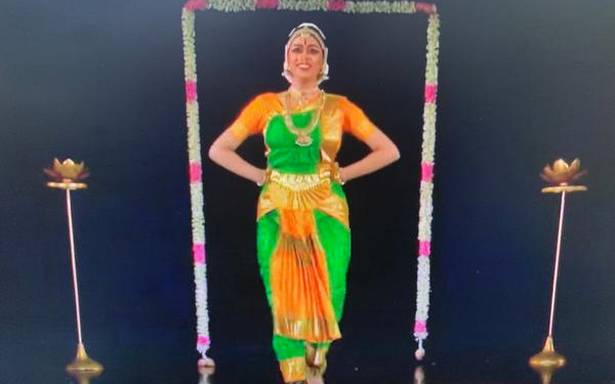Aditi Ramprasad’s nritta and abhinaya was good but she needs to add a dash of lyricism
Two tall lotus lamps on either side of a doorway decorated with flowers added to the ambience at Aditi Ramprasad’s online performance. Titled ‘Hridaya Kamalam’, the focus of the evening’s repertoire was on anahata chakra (heart chakra), the most influential energy centres among the seven chakras, symbolised by a lotus with 12 petals.
Preceded by a brief shlokam, the performance began with a Tisra Alarippu. The various ragas played on the violin and the flute alternately as a refrain to the sollukattus was interesting. A Jathiswaram composed by the Thanjavur Quartet in Chakravaham followed next.
The glory of the sun god was portrayed by a Surya Shabdam, set to music by Vanathi Raghuram and with lyrics by Dr. S. Raghuram.
A beautiful Taana Varnam composed by Dr. S. Ramanathan in raga Behag dedicated to the goddess Meenakshi was the central composition of the evening. Aditi portrayed the many moods of the piece. Stories from the lives of Kumaragurupara Desikar, who composed Meenakshi Pillai Thamizh, and from Appayya Dikshitar were taken up for sancharis. The jathi interludes were marked by clarity of footwork and hand movements. Some more focus on bringing in lyricism and grace would have enhanced the visual appeal of the adavus.
The beauty of raag Behag as visualised by the composer came alive in the voice of Murali Parthasarthy, aided by Ananthkrishnan on the violin and Sruthisagar on the flute. Guru Bharadwaj’s mridangam virtuosity and Lakshmi Ramaswamy’s cymbals complemented the performance.
A lively Kavadichindhu, ‘Villinai otta’ by Subramania Bharati, and a Kapi raga composition by Ambujam Krishna, ‘Aravinda padamalar’, gave ample scope for abhinaya and the dancer made good use of it. A thillana in Navarasa Kanada provided a fitting end.
The Chennai-based reviewer
writes on classical dance.
Source: Read Full Article

